Q&A: Debris from reconstruction work creates mess in neighboring building
Question: My apartment building is about 10 feet from a small, nine-unit complex. That building’s homeowners association undertook reconstruction work involving significant re-landscaping, iron railing repairs, brick masonry, patios and common walkways. All this work faces our building’s front doors.
I had incorrectly reasoned the homeowners association would be a considerate neighbor during this time. But when I returned home, I noticed six large trees had been removed and my kitchen and living room were covered with a thick layer of dirt, dust and wood debris that had been pushed through window sills and under my apartment door, covering my floors, rugs and walls.
I wrote to the homeowners association president and politely requested that she provide 24-hours notice of any further exterior renovation so I could take precautions. I also asked when the work would be completed. She apologized, then referred me to the homeowners association manager, who said they ran into unforeseen circumstances that created small but unavoidable impacts. He then said that not only could he not tell me when the work would be completed but that he didn’t owe me any further response.
On a daily basis, I continue to suffer from mounds of dirt, dust and wood debris stuck to my sliding doors and windows and lodged throughout my unit and on my personal belongings. This is a time-consuming mess to clean up every day and has also exacerbated my allergies. Since the president and manager are dismissive of my concerns and requests for good neighborliness, what recourse do I have?
Answer: It may not be neighborly, but depending on your local ordinances this manager may be correct that no notice is required. But being potentially correct about a notice requirement won’t prevent the homeowners association from being part of a lawsuit and subject to damages.
It may also be possible that notice was given to your landlord or the owner of your building but not to you directly. Most construction cannot be performed without the appropriate city permits. With a little bit of time spent at City Hall, you might find information related to the extent of the homeowners association’s reconstruction plans.
Regardless of issues pertaining to notice and dissemination of scheduling information, the association cannot damage your property. It must take reasonable steps to reduce the effect of its construction and repairs on your unit. The intrusion of dirt, dust and debris is a nuisance and/or interference with the quiet enjoyment of your residence and may also constitute a physical trespass onto your property.
Even where the effects of construction are not invading your property, an action for a private nuisance may allow you to recover for the inconvenience and interference you have suffered. You should be diligent in recording and documenting your damages, which include time and money spent cleaning or taking time off work for illness or doctor appointments as well as other physical ailments or lack of sleep you may suffer. Keep the manager and association updated with your growing damages and repeatedly demand, in writing (return-receipt requested), compensation for the same. You may want to copy your landlord on that correspondence and request the landlord’s assistance with your efforts.
Depending on the extent and urgency of the damages, you may also consider pursuing claims in civil or Small Claims Court for the association’s failure to take adequate precautions with regard to its construction project. Clearly, the association has a duty to act reasonably with respect to its construction efforts and refrain from negligently taking actions, or from failing to take reasonable actions, that result in damage to you and your property.
Although Small Claims Court may be an expedient option for you to recover a monetary award, a restraining order or injunction in civil court may be necessary to preserve your health and quiet enjoyment.
Also, a judge may issue a temporary restraining order until the case can be reviewed to determine whether the association has been negligent or to prevent further trespass and damages with its current project.
If the association’s construction site rises to the level of a public nuisance pursuant to California Health and Safety Code section 11573, then the judge may similarly enjoin the work until reasonable measures are put in place to remediate the damage and prevent more damage in the future.
As an agent for the association, all the manager’s actions, including his rudeness, are attributable to the board. Although there is no law requiring association managers to be polite to their neighbors, doing so just might diffuse a potentially volatile situation and save owners from paying out costly damages.
Zachary Levine, partner at Wolk & Levine, a business and intellectual property law firm, co-wrote this column. Vanitzian is an arbitrator and mediator. Send questions to Donie Vanitzian JD, P.O. Box 10490, Marina del Rey, CA 90295 or noexit@mindspring.com.
More to Read
Sign up for Essential California
The most important California stories and recommendations in your inbox every morning.
You may occasionally receive promotional content from the Los Angeles Times.






